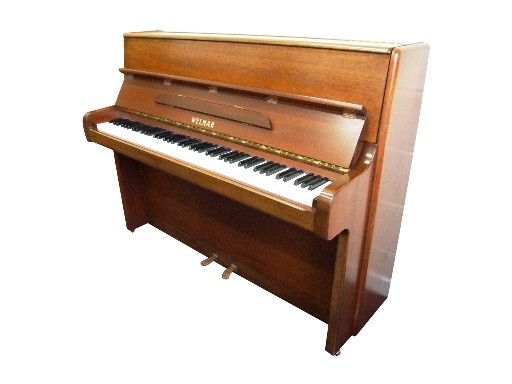English pianos
In the UK there are still many fine small upright pianos made by English firms from about 1960 to 1990. These are generally far better made than the same size piano made today, as from about 1920 to 1985 (uprights from about 1960 to 1985) many British firms specialised in making small pianos. With much competition, high skill levels and great demand, the quality of the best ones was extremely high. The most common good ones are by Knight and Welmar with some of the small uprights made by Kemble, Rogers, Broadwood and Chappell also being well made. As a rule, these English pianos were far better made than the equivalent new ones from the Far East. This is because most of the far eastern small uprights are scaled down copies of the taller ones, and often produce an uneven and brash thin tone. Recent examples of this are the Yamaha E108 and LU101 and B1 which in our opinion don’t have a pleasing tone. Small modern upright pianos date from about 1960 to the present day and the best period of manufacture was from about 1965 to about 1990. Some of these can be quite worn, so much advice is needed before purchasing. Another fine small upright found in the UK that we like very much is by Fazer, made in Finland from about 1975 to 1990.
Welmar upright pianos
Piano advice
Do you need book holders?
If you use thick music books, then a pair of book holders can be fitted to most small pianos. Older uprights usually have them, and modern ones. Most serious musicians require them.
Practice pedal
Some uprights are fitted with a third practice pedal, and we can fit this to most other pianos in the form of a lever under the keyboard. This inserts a piece of felt between the hammer and the strings, making it very quiet. This may be useful if you have thin walls or need to practice in the same room as others, but the tone is not as good as when played normally.
Wooden floor?
It’s most important to note that as the soundboard vibrates the sound bounces back off a wooden floor, making the piano sound much louder than it does on a carpeted one. If you’re buying a soft toned piano such as an old style Bluthner then this may not be a problem. However if you’re buying a bright sounding modern Yamaha or Bosendorfer then it’s likely you’ll need to put a rug under the piano, and may also need to introduce other absorbent material to the room such as drapes or tapestries. In this way you should be able to arrive at the ideal acoustic. [NB if you have underfloor heating you will have to be extremely vigilant to keep the temperature low and the humidity above 40% and ideally 50%.]
Is there enough leg room?
Leg room on small pianos is limited. If you are tall then you will probably have to use a chair which is lower than a piano stool, or an adjustable stool at minimum height. small modern uprights are usually about 62cm from the floor to the underside of the keyboard. By comparison tall Yamaha U3 upright has leg room of 62cm whereas a German Steingraeber 118 has 70cm and an older Bluthner 65cm. A small modern Zender has only 58.5cm!
For baby grand pianos please click here

